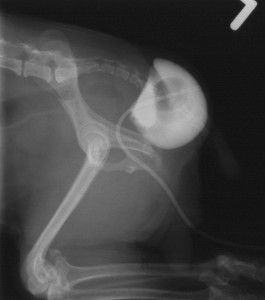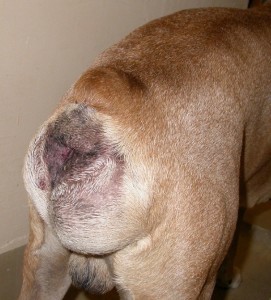
Perineal Hernias
By Jacqui D.Niles, BVetMed, Cert SAS, Diplomate ACVS
Perineal hernias occur most frequently in older, non-castrated male dogs, although there are a few reports of perineal hernias in female dogs and an increasing number of reports describing perineal hernias in cats. The exact cause has not been determined although there are numerous theories to explain why the pelvic diaphragm weakens and fails to support the pelvic organs, including straining secondary to chronic constipation, enlargement of the prostate or pregnancy in female dogs, imbalances of sex hormone concentrations and tail-docking.
ARE CERTAIN BREEDS OF DOG MORE AT RISK ?
Miniature poodles, Shetland Sheepdogs, Boston Terriers, Pekingese, Dachshunds, Boxer dogs and Corgi’s are frequently reported to be affected in the Veterinary Literature.
HOW DO I KNOW IF MY PETS HAS A PERINEAL HERNIA?
Most animals present because of difficulty defecating and/or because the owners have noticed a swelling lateral to the anus.
- Swelling to one side or both sides of the anus
- Straining to pass bowel movements in up to 75–80% of cases.
- Rectal prolapse
- Lethargy
- Depression
- Anorexia
- Altered tail carriage
- Straining to urinate or complete inability to urinate if the bladder is trapped in the hernia.
- Vomiting if there is intestine trapped in the hernia
HOW ARE THEY DIAGNOSED?
Perineal hernias are diagnosed by performing a digital rectal examination. Rectal sacculation and lack of lateral rectal wall support is easily detected. Some patients may require analgesic or sedative administration for completion of a rectal exam. X-rays or ultrasound can be used to confirm if the bladder or intestines are trapped in the hernia. Other structures which may be encountered within the hernia are prostate, prostatic cysts and in female dogs the uterus.. Blood work is usually unremarkable unless the bladder or intestines are trapped.
Patients demonstrating any swelling next to the anus along with the clinical signs listed above should seek veterinary advice as soon as possible. Organ entrapment into the perineal hernia may be life threatening and necessitate emergency stabilization prior to definitive surgical intervention.
X-ray with contrast showing the bladder located in the perineal hernia instead of in the abdomen.
Due to the risk of bladder involvement, all perineal hernias should be managed surgically by reconstruction of the pelvic diaphragm. Castration is carried out at the same time as surgery to repair the pelvic diaphragm since an enlarge prostate may have led to development of the hernia initially. Dogs not castrated at the same time as hernia repair have a greater risk of recurrence of the hernia.
Entrapment of a loop of intestine into the hernia can cause significant pain and loss of the blood supply to the affected piece of intestine. Emergency surgery is indicated for pets with signs of abdominal pain, inability to urinate, and a strangulated loop of small intestine.
HOW IS THE HERNIA REPAIRED?
Internal Obturator Transposition
A number of techniques have been described for the repair of perineal hernias, however, the technique with the highest success rate (90%) is repair with transposition of the internal obturator muscle. This involves using a muscle in the animals pelvic canal to act as a patch over the hernia defect.
WHAT AFTERCARE IS NEEDED?
After surgery, your pet may be placed on a broad-spectrum antibiotic and pain medications to reduce their post-operative discomfort. Postoperative care should include stool softeners (indefinitely) and monitoring defecatory function for the first few days.
Your pet should be kept calm and quiet for the first two weeks after surgery to allow for tissue healing. Plastic collars are needed to prevent patient damage to the surgical repair. Swelling and bruising is not uncommon after surgery in this region and should resolve over the first post operative week. Cold compresses in the first 3-4 days can help alleviate the swelling if your pet will allow it.
WHAT ARE THE POTENTIAL COMPLICATIONS?
The prognosis is good for the majority of cases. Wound infection and recurrence of the hernia are the major problems reported. .In 10-15% of the cases, recurrence of the hernia may occur within a year.
Additional complications include rectal prolapse, urinary or fecal incontinence (rare), sciatic nerve injury (very rare), and perineal abscessation or fistula formation (rare).
Rectal eversion / prolapse can occur immediately after surgery. Lubrication with local anaesthetic gel and gentle reduction combined with a temporary purse string suture are usually all that is necessary. Where rectal prolapse recurs, additional surgery (incisional colopexy) should be performed to prevent further prolapse.
There is no proven means to prevent perineal hernias from forming. The problem is rarely seen in castrated male dogs so early castration in dogs not intended for breeding purposes is recommended.
